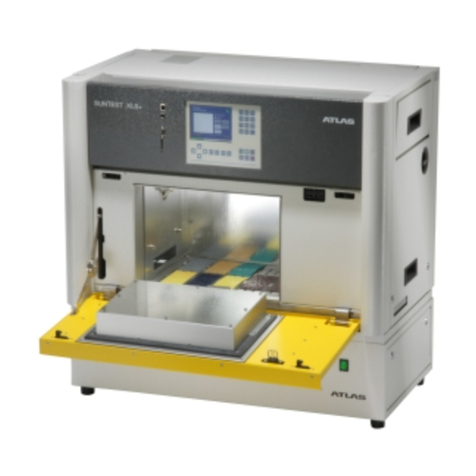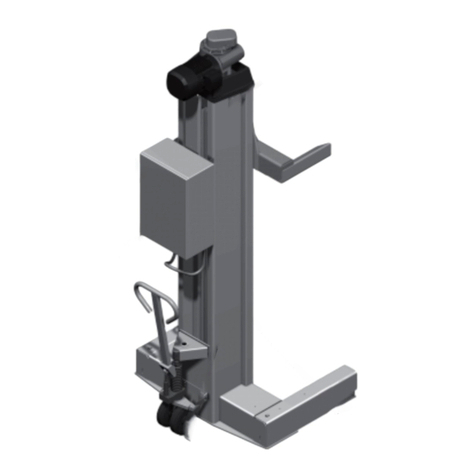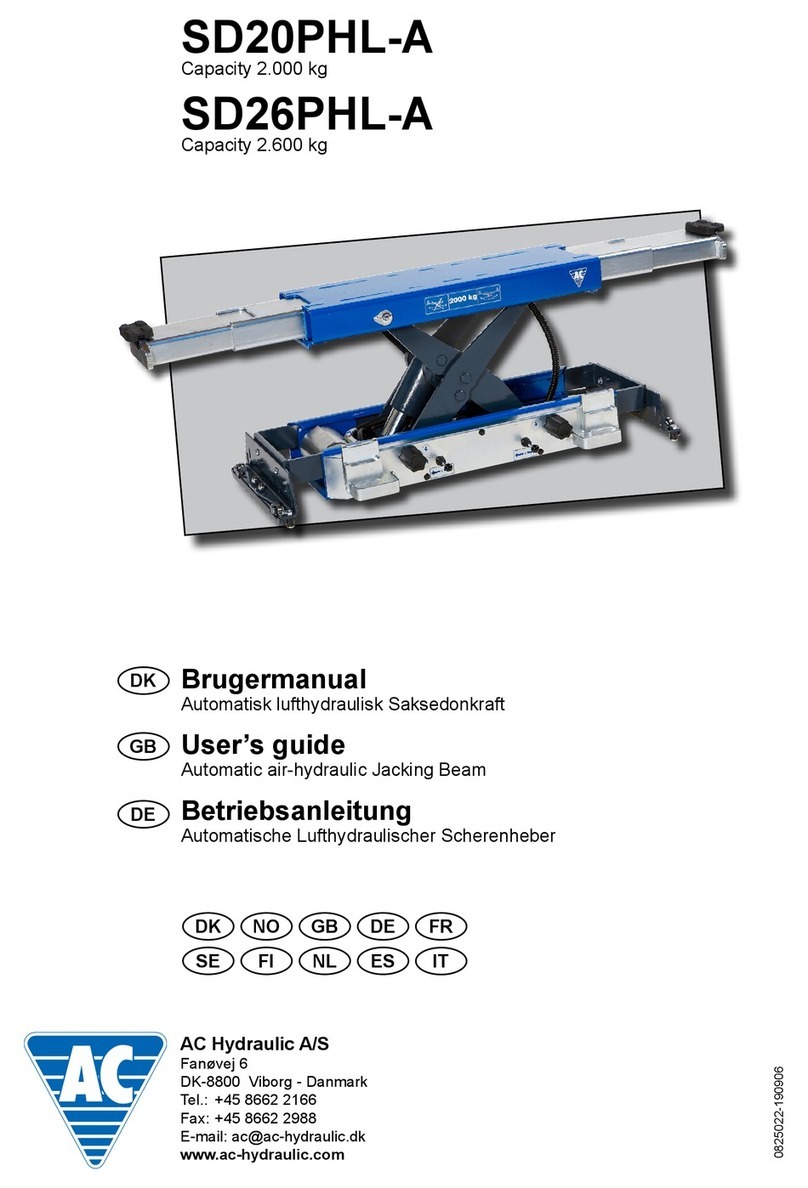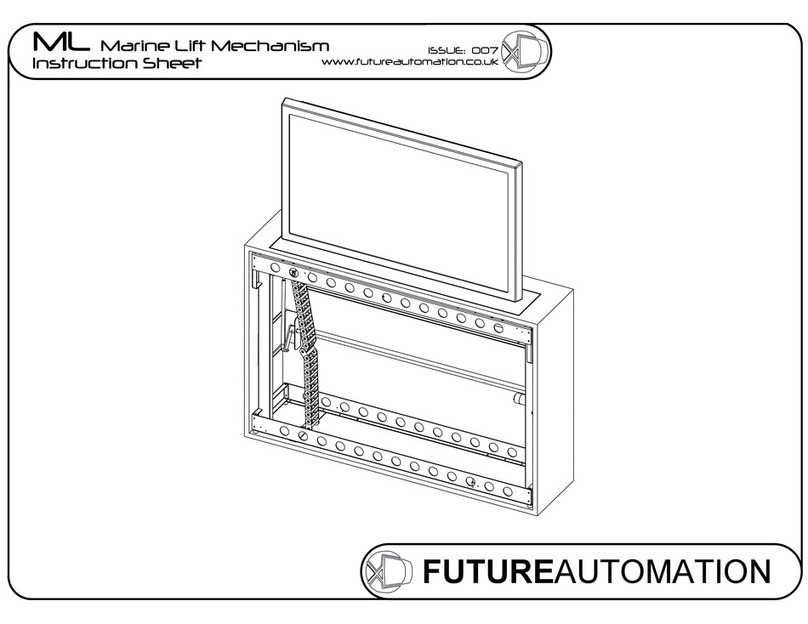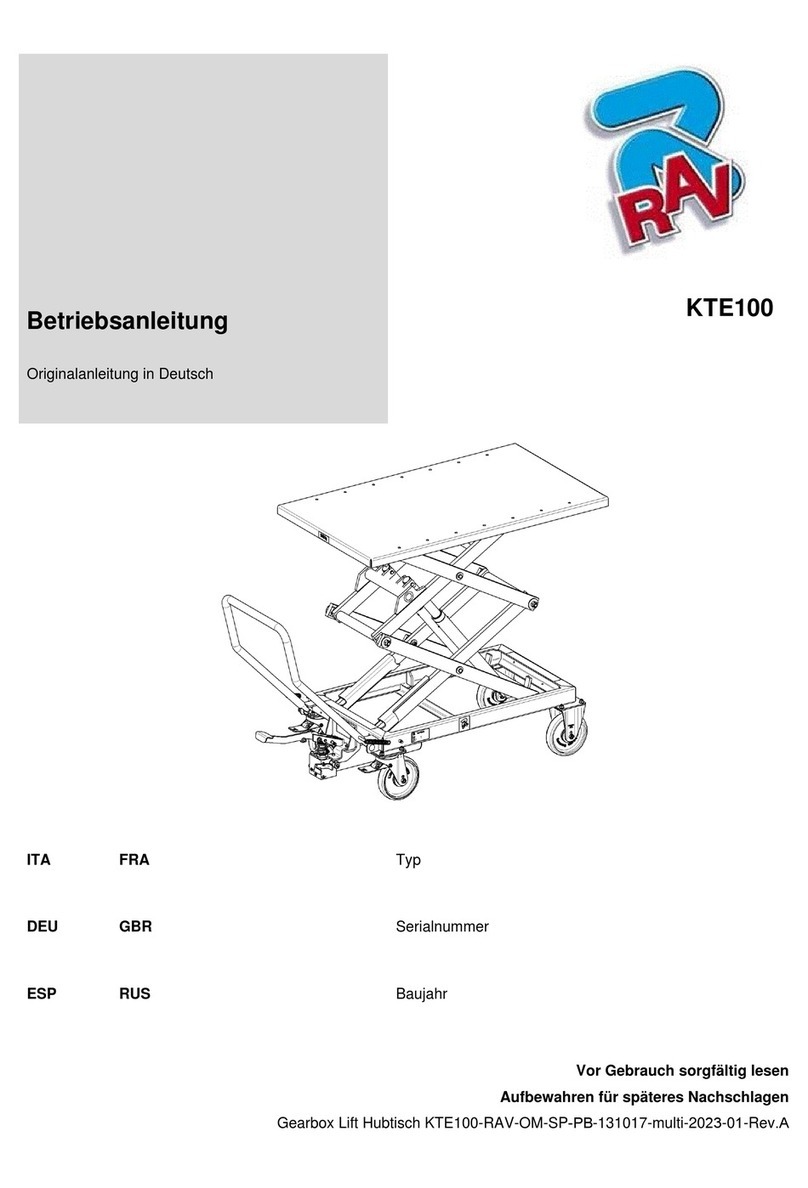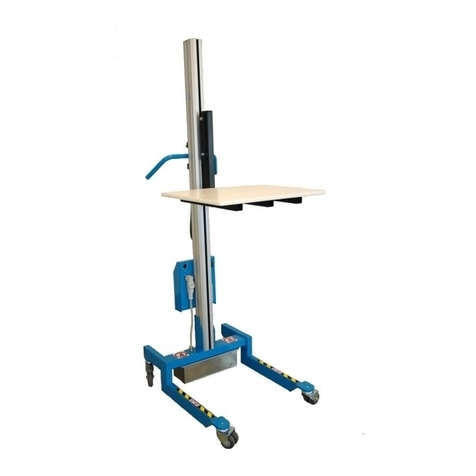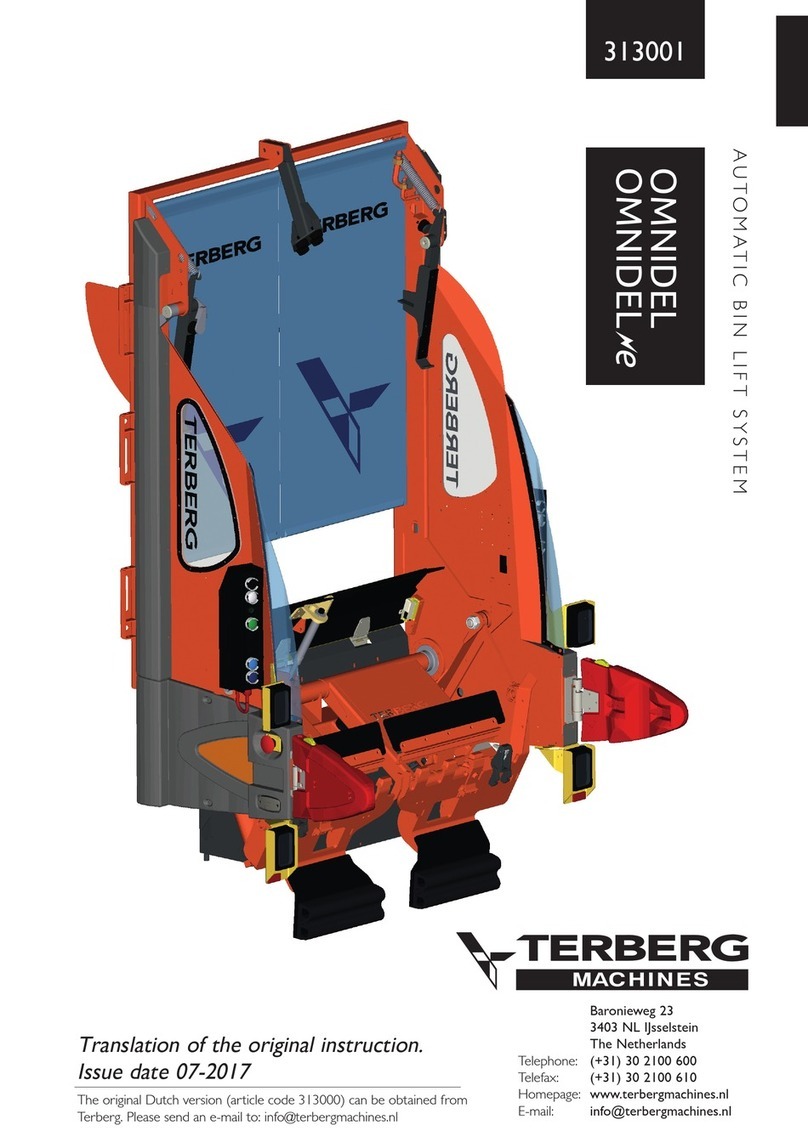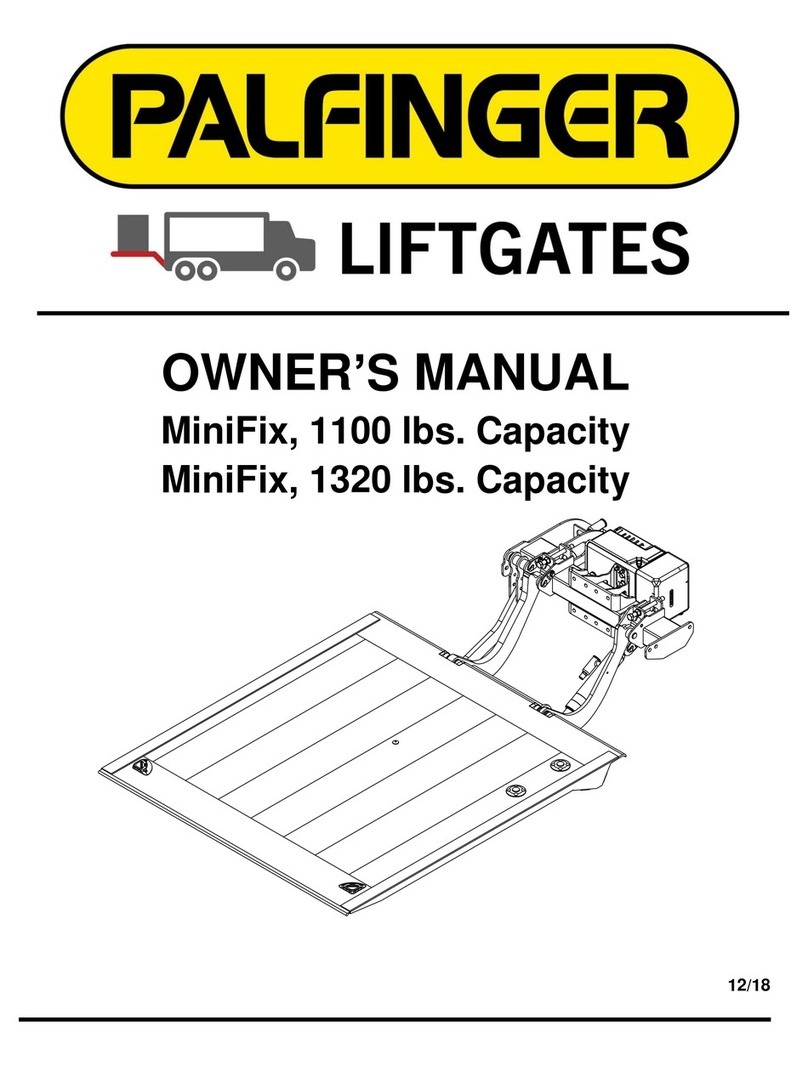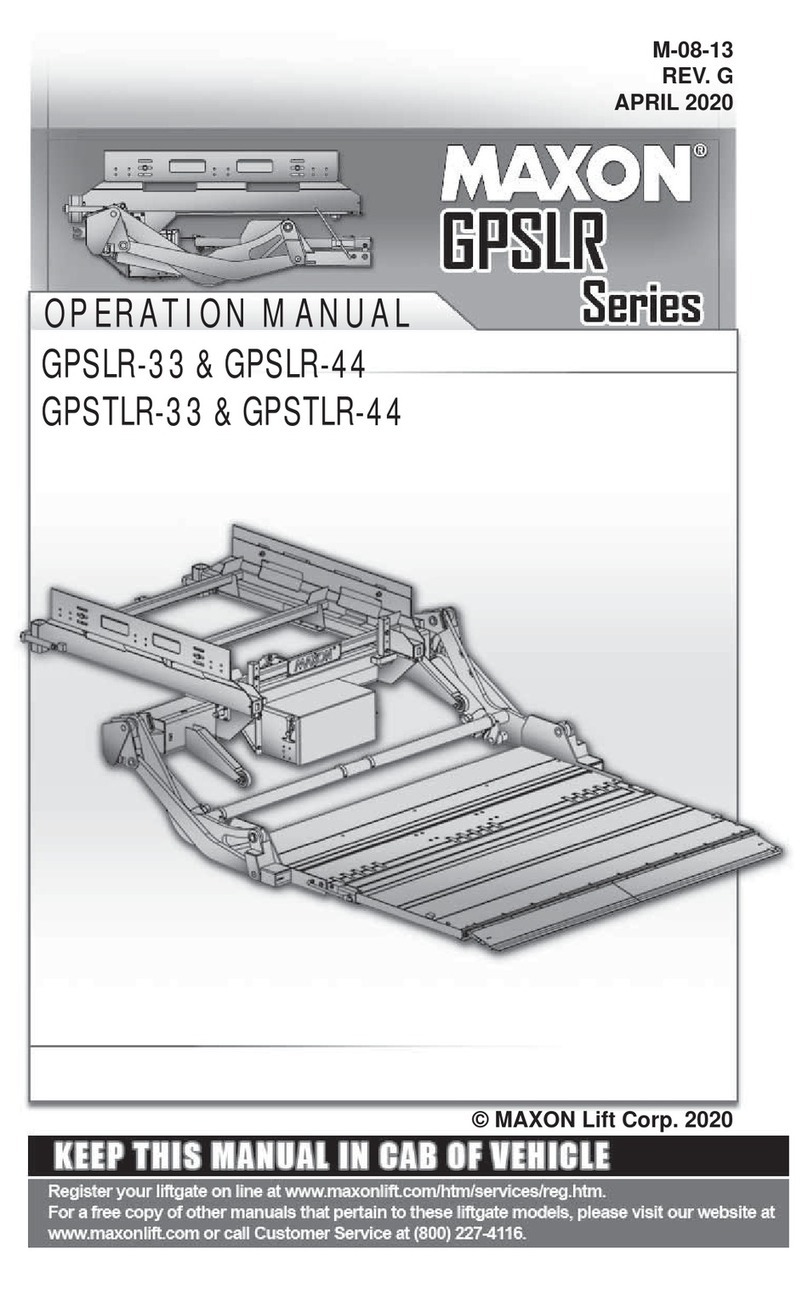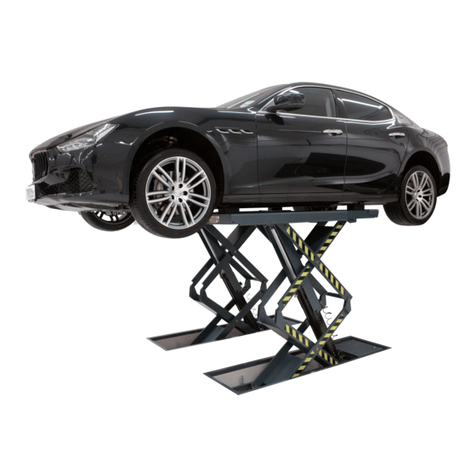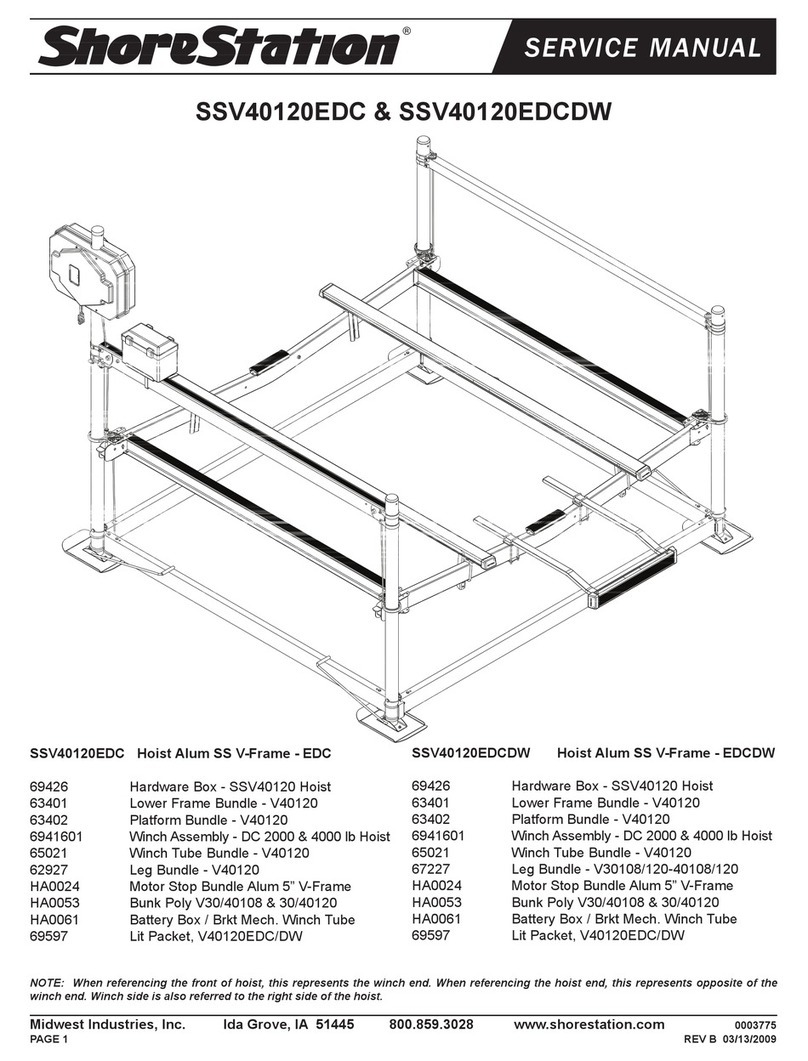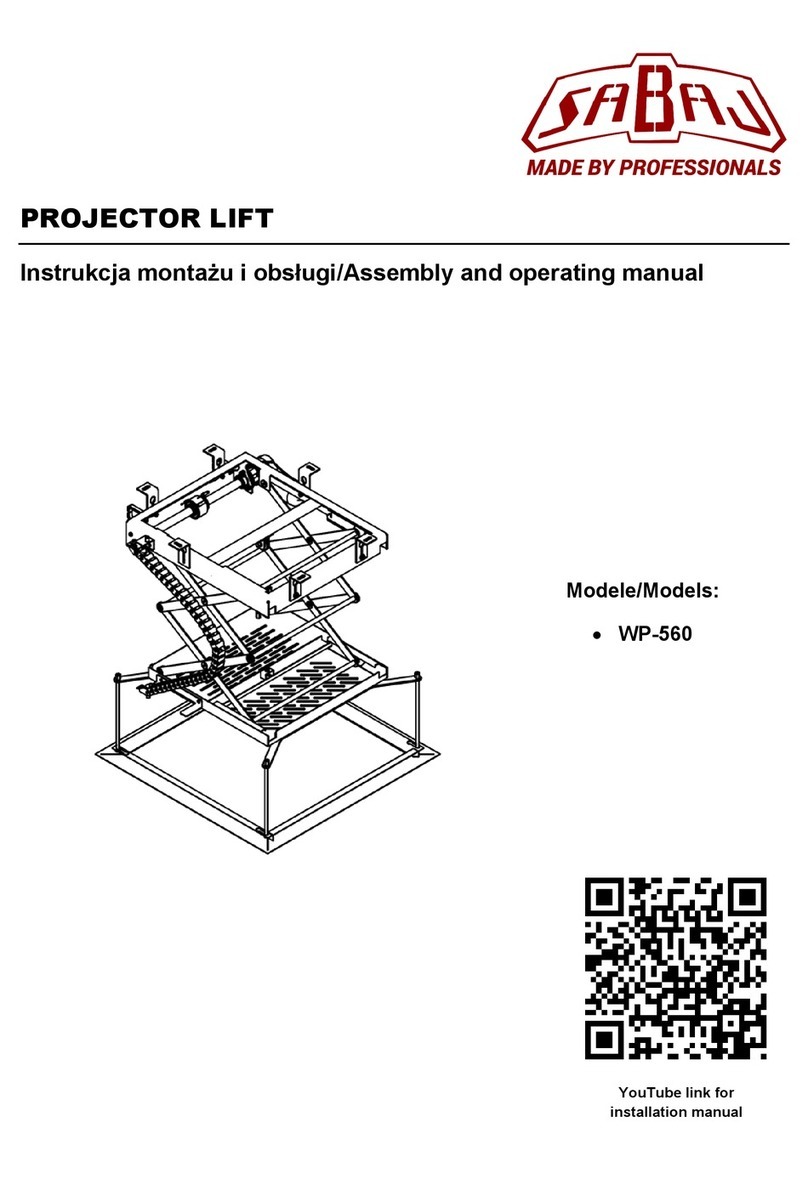Active Mobility NEOS 150 Folding User manual

NEOS 150 Folding
MOBILE PATIENT LIFTING HOIST
USER MANUAL
IMPORTANT:
Do not use the Neos 150 Folding PATIENT LIFTING HOIST
without having first read this anual.
Unit 8, 110-120 Silverwater Rd, Silverwater NSW 2128
Phone: 02 9649 2111
E ail: sales@activemobility.com.au
www.activemobility.com.au

Doc Neos 1.1
NEOS 150 Folding User Manual | 2
CONTENTS
NEOS 150 Folding Overview 3
I portant safety considerations 4
NEOS 150 Folding Asse bly instructions 6
Folding instructions 7
Hoist operation and charging 8
Lifting procedures 11
Maintenance 13
Trouble shooting 14
Specifications 15
Warranty 16
Slings 17
Key to sy bols 18
Parts list 18
Log book 19

Doc Neos 1.1
NEOS 150 Folding User Manual | 3
Neos 150 Folding
Overview
The NEOS 150 Folding
is
a co pact ergono ic designed
ediu sized heavy duty obile patient lifting hoist with a
safe working load of 155kg.
This lifter is ideally suited as a co pact and lightweight hoist in
a ho e care environ ent.
The NEOS 150 Folding whilst being co pact provides
superior patient space. The NEOS 150 Folding in fact offers
ore patient space than ost other larger size lifters. The
swivel feature of the detachable yoke allows a patient to be
rotated through 360° at full lift height, thus aking the carer’s
job easier and safer.
The NEOS 150 Folding lifting range allows patients to be
lifted fro the floor, bed or chair with ease and safety.
The NEOS 150 Folding is a powered unit using trusted
industry leading LINAK co ponents, giving a safe working
load (SWL) of 150kg
Options available with the NEOS 150 Folding
Standard spreader bar
Weighing device¹
The ALLEGRO CONCEPTS range of patient lifting equip ent,
including lifters, slings and accessories, has been designed
and tested to co ply with AS ISO 10535 – 2011, (Hoists for
the transfer of disabled persons – Require ents and test
ethods)
¹
CAUTION - Weigh scale is not intended for clinical assess ent.

Doc Neos 1.1
NEOS 150 Folding User Manual | 4
IMPORTANT SAFETY CONSIDERATIONS
INTENDED USE OF THE PRODUCT
The
NEOS 150 Folding
co pact obile patient lifting hoist has
been designed to lift and transfer a less able person with the
assistance of a carer.
The
NEOS 150 Folding
should be used with one of the ALLEGRO
range of patient slings, as assessed by a co petent trained person.
NB. Not all slings and accessories are compatible with this hoist. If
you are unsure please contact ALLEGRO CONCEPTS.
The correct and appropriate use of the
NEOS 150 Folding
hoist
will reduce the risks associated with anual patient handling. The
lifting / transferring task should be assessed & planned by a trained
user.
SAFETY CONSIDERATIONS
Ensure that all users read this guide before operating the
hoist.
Do not operate the hoist without training in the safe
operation of hoists & slings. IF IN DOUBT DO NOT USE.
Only use slings which have been assessed as suitable by a
co petent trained professional.
Read the relevant sling users guide which is provided with
each sling, before use.
Do not use the hoist if there is any doubt about wear or
da age to the unit. In particular the spreader bar or the
ALLEGRO Pivot Fra e.
Do not use the hoist if there is any fraying or stitch da age
to the sling or if the sling is da aged in any other way.
DO NOT EXCEED THE SAFE WORKING LOAD OF THE
NEOS 150 Folding
HOIST 150kg
Ensure when the hoist is in use that the surrounding area is
clear and the person being lifted is clear of all obstructing
objects.

Doc Neos 1.1
NEOS 150 Folding User Manual | 5
Jib
Battery &
Control
Box
Push
Handle
Mast
Leg
Base Chassis
Spreader
Bar
Actuator
Direction of Travel

Doc Neos 1.1
NEOS 150 Folding User Manual | 6
ASSEMBLY INSTRUCTIONS
NEOS 150
Folding
The ALLEGRO range of patient lifting and transfer hoists are fully
asse bled, load tested and certified at the factory before being partially
dis antled for packing and shipping.
Use the instructions below as a guide to asse ble your
NEOS 150
Folding
hoist
.
1. Re ove lifter co ponents fro protective packing and lay out
on a s ooth surface to prevent da age to powder coating on
lifter sub asse blies.
2. Lift the ast asse bly and slide into ast holder receiving
socket on base chassis. Ensure the ast asse bly is
co pletely engaged in the ast socket. Insert the locating bolt
through the chassis and base and tighten the locking levers to
prevent ove ent between ast and base chassis.
3. Attach lift actuator to jib, by aligning actuator clevis with actuator
ount bracket. Insert bolt and tighten nylock nut.
4. Attach push handle asse bly with bolts supplied with handle
asse bly.
5. Attach battery by clipping battery pack on top of control box.
6. Plug the lift actuator cable into port 1 positioned on the
underside of the control box, ensuring it is driven fir ly ho e in
the socket.
7. Your
NEOS 150 Folding
hoist
uses a anual leg
adjust ent via a foot pedal. This leg adjuster does not need any
further asse bly.
8. Plug the handset lead into the large socket on underside of
control box. (See next diagra ) ensure align ent of tongue on
handset plug with groove in control box handset connection
port. When aligned press ho e fir ly. A s ear of Vaseline on
the o ring ay assist if plug is tight.
9. Check operation of lifter via handset, ensuring that the RED
EMERGENCY STOP BUTTON ON THE CONTROL BOX IS
RELEASED. Turn the knob quarter turn clockwise to release.

Doc Neos 1.1
NEOS 150 Folding User Manual | 7
FOLDING INSTRUCTIONS
1. Lower boo or jib to its lowest position and press the safety
stop button.
2. Close legs to it narrowest position
3. Pull lever on base to close legs co pletely
4. Secure the boo to the ast with the catch provided under
the lower part of the ain actuator.
5. Undo hand lever on side of chassis and re ove ast
location bolt
6. Gently lift the ast up a little and fold down towards front.
7. Secure ast with straps located at end of legs.
8. Insert Mast locking bolt thru the location holes and tighten
with the hand levers
9. Hoist can be lifted by the handles and oved, using the rear
wheels as a trolley.

Doc Neos 1.1
NEOS 150 Folding User Manual | 8
HOIST OPERATION AND CHARGING
HANDSET
The handset activates the lift actuator by the use of two low
pressure buttons, protected by a strong plastic cover. These
are sy bolised by arrows (diagra ). The arrows indicate the
direction of travel to raise or lower the hoist jib. When either
button is released the jib will re ain in position.
The
NEOS 150 Folding
hoist incorporates an actuator
driven leg opening adjust ent. Two buttons will be seen on
the handset with arrows and sy bolised legs indicating the
direction of travel. This function allows an unrestricted range
of leg adjust ent.
The handset is also fitted with a battery indicator light. This
will flash when the batteries reach a axi u discharge of
18 volts. NB the light will only flash when the hoist is under
load.
The connection for the handset is located on the underside
of the control box.
Handset Port
Lift Actuator –
Port 1

Doc Neos 1.1
NEOS 150 Folding User Manual | 9
ACTUATOR
The
NEOS 150 Folding
obile patient lifting hoist uses a LINAK
single speed actuator with an e ergency controlled lowering release
handle. (Lift up red tab located at base of actuator). This allows the
patient to be lowered in the event of a fault in the hoist or deep
discharged batteries.
CHARGING
The
NEOS 150 Folding
is supplied with a LINAK external wall
ount charger. This is powered by plugging the 3 pin plug into a
standard 240V ac outlet
To recharge the battery pack, perfor the following steps
1) Release battery pack fro control box by pulling the handle
on the pack towards you. Use both hands to support the
battery pack when re oving or replacing it.
2) Clip the battery pack fro the control box onto the charging
unit, ensuring it is seated properly on the charger base
3) Charger will auto atically activate the charging sequence
CHARGING INDICATOR DISPALY
GREEN ains power on light will be illu inated when
connected to 240 v power supply.
ORANGE LIGHT illu inated indicates battery currently
charging.
ORANGE LIGHT will extinguish when battery pack is fully
charged.

Doc Neos 1.1
NEOS 150 Folding User Manual | 10
NEOS 150
Folding
External Charging Unit
CHARGING DOs & DON’Ts
DO
Do charge the battery whenever possible. This will extend the battery
life. A large nu ber of cycles can be obtained fro operating on the
batteries, but battery lifeti e is reduced with frequent discharging.
Do inspect all cables particularly the ains power cable on
the charger for any da age; replace where necessary.
Do stow the handset and if fitted with charger, the ains
power cable when transporting the hoist.
Do clean the actuators, control box, charger, battery and
handset at regular intervals to re ove dust and dirt.
DON’T
Don’t allow the batteries to fully discharge before connecting
to charger. The batteries are a lead acid gel type that can be
trickle charged continuously and have a high current
discharge capacity. The batteries are not the nickel cad iu
type and ust not be periodically fully discharged. Battery
life is greatly reduced by deep or co plete discharging of the
batteries. Longer lifeti e is obtained by aintaining fully
charged batteries.

Doc Neos 1.1
NEOS 150 Folding User Manual | 11
LIFTING PROCEDURES
Carer should be fully conversant and trained in the use of
lifter and sling. This will decrease patient apprehension and
increase their co-operation and overall safety of the lifting
process.
Where possible always pull the lifter for axi u safety and
co fort.
Move the hoist slowly to avoid patient swing whilst standing.
The hoist should not be used on uneven surfaces or on an
incline greater than 5 deg.
Never leave a patient in a sling unattended.
Ensure brakes of the chair, bed, trolley that the patient is
being lifted fro are locked.
The braking castors on the lifter should be off. This allows
the lifter to create its own centre of gravity (C.G,) over the
weight of the patient.
NB. This action may result in the lifter moving slightly during
the initial phase of the lift.
GENERAL LIFTING PROCEDURE
The infor ation supplied below is not intended to be construed as a
training anual but as a general guide to lifting procedure only.
Fit sling to patient
(REFER TO SLING INSTRUCTION FOR USE).
Manoeuvre the hoist around the patient, adjusting the legs to
fit around chair, wheel chair etc. If lifting fro a bed ensure
under bed clearance is sufficient to anoeuvre the lifter legs.
Lower the spreader bar sufficiently to allow fitting of sling
attach ent loops onto the spreader bar hooks. Ensure
spreader bar does not contact with patients face or body.
Use the handset to raise the hoist boo enough to take up
the patient’s weight. At this point stop the lift, check all sling
attach ents are secure and that the sling is positioned
correctly. Check patient co fort. Lower and realign sling if
necessary.
Continue to lift until patient is clear of chair, bed etc.
ensuring that during the course of the lift the patient is clear
of any obstructions.

Doc Neos 1.1
NEOS 150 Folding User Manual | 12
MOVING THE PATIENT
A PATIENT HOIST IS PRIMARILY A LIFTING DEVICE. If possible
always ove patients fro roo to roo in a wheelchair or other
transport device. However, if you ust ove a patient while
supported in a lifter the following are suggested:
Lower the patient so the feet are just off the ground. This
enhances the patients’ perception of security.
Where possible always pull the lifter rather than push, in
particular when changing direction or steering around
corners.
Walk the rear of the hoist around so that it is heading in the
new direction.
Whilst anoeuvring in a s all or confined area, two carers
will ake the job easier.
Move the hoist s oothly and avoid abrupt stops and turns to
ini ise patient swing.
LOWERING THE PATIENT
Position the patient over the chair or bed to be lowered onto
and begin the lowering procedure with the handset down
button. Check to ake sure the patient re ains co fortable
during descent.
.
All General Purpose have handles sewn onto the back of the
sling. These will assist the carer to pull back the patient into
the correct position for seating.

Doc Neos 1.1
NEOS 150 Folding User Manual | 13
GENERAL MAINTENANCE
To prolong the working life of the lifter and for trouble free operation
it is reco ended that periodic inspections should be perfor ed
routinely and as often as necessary. Periodic inspections should be
perfor ed by a person who is suitably qualified and well acquainted
with the design, use and care of patient lifting hoists.
If inspection reveals that the safety of the hoist is jeopardised in any
way the hoist should be IMMEDIATE Y WITHDRAWN FROM
SERVICE, tagged as such and the owner notified.
MAINTENANCE GUIDE & CHECK LIST
General visual inspection of lifter.
Check castors are tightly attached to legs.
Check castors run & swivel freely, re ove any hair & fluff
fro axle.
Check castor brakes operate efficiently.
Over haul castors & pack with grease.
Inspect surfaces for scratches & chips
Clean surfacers with a neutral detergent; re ove any
adhesive tape with orange or eucalyptus oil.
Exa ine all oving parts and fasteners for wear and fatigue,
lubricate and /or adjust as required.
NB leg pivot bushes incorporate a Teflon coated pivot bush
which requires ini al lubrication.
Check tightness of bolt in leg bushes.
Check linkages are secure in leg adjuster ball joints.
Check all electrical co ponents for correct operation.
Check battery charger operation.
Re ove dirt & dust fro actuator.
Wipe actuator shaft with oiled rag (DO NOT use WD40 or
equivalent.)
Check ast to boo pivot point, re ove bolts and lightly
regrease bush and retighten, ensuring free ove ent at
pivot.
A MAJOR SERVICE SHOULD E CARRIED OUT EVERY 12
MONTHS AS A MINIMUM REQUIREMENT.
IMPORTANT: An annual load test to the safe working load (swl)
is required for compliance with AS ISO 10535 2011

Doc Neos 1.1
NEOS 150 Folding User Manual | 14
TROUBLE SHOOTING
WARNING TROUBLE SHOOTING SHOULD ONLY BE CARRIED
OUT BY ALLEGRO CONCEPTS AUTHORISED PERSONNEL
FAMILIAR WITH BOTH USE, ELECTRICAL AND MECHANICAL
FEATURES OF PATIENT LIFTING HOISTS.
The following is a guideline only to general trouble shooting.
Before carrying out any trouble shooting ensure that.
Red e ergency stop button is released.
Maintenance procedures checked & followed.
All cable connections are secure.
Battery is fully charged.
Actuator cannot lift full load or
runs slow.
Actuator will not run via
handset
but control box relays click.
Warning buzzer sounds within
control box
Battery charger
power indicator
LED does not light up.
o response from control box,
no clicking of relays is heard.
Actuator will not run and no
relay
click is heard from control box.
Actuator works in one
direction only
POSSIBLE FAULT
o mains connection.
Internal fuse blown.
Battery chargers is defective.
Control box is defective.
Handset defective
Actuator plug not
pushed
in to
control box,
Actuator defective.
Control box defective.
Batteries not charged / defective
.
Load too high for lifter.
Actuator motor damaged.
Emergency stop button engaged.
Hoist battery completely flat.
Blown fuse in battery pack
.
Faulty control box.
Handset defective.
Control box defective.
Flat battery pack.
Faulty battery pack.
ACTION
Plug into mains.
Replace fuse.
Repair/replace charger.
Replace control box.
Charge/replace batteries.
Replace actuator.
Push firmly into
correct port.
Replace actuator or control.
Release
emergency stop
button.
Charge battery.
Replace/repair control box.
Replace handset.
Repair/replace control box.
Recharge battery.
Replace battery.

Doc Neos 1.1
NEOS 150 Folding User Manual | 15
NEOS 150
FOLDING
SPECIFICATIONS
Safe working load (SWL) 150kg
Base length 1290
External base width 615
Internal base width closed 550
Internal base width open 890
Maxi u internal length 950
Base width adjust ent
Manual Adjust ent
Base height / under bed clearance 135
Mini u height of spreader bar 410
Maxi u height of spreader bar 1650
Hoisting range 1240
Lifter weight 35kg
Patient lift space 820
Under base height 80
Maxi u hoist reach 880
Mini u hoist reach 44
Turning radius 1350
Weight of heaviest part (Base asse bly) 10.kg
Handle height 1000
Electrical approval EN 60601-1
Sound level < 40Db @ 1
Electrical approval EN 60601-1
Operation force - Finger < 4N
Hand < 50N
Foot < 50N

Doc Neos 1.1
NEOS 150 Folding User Manual | 16
WARRANTY
ALLEGRO CONCEPTS PTY LTD warrants its products to be free
fro defects in aterials and work anship under nor al use and
service and will within the period stated below, fro the date of
purchase, repair or replace without cost to the original custo er, any
part asse bly or portion thereof which shall be returned to
ALLEGRO CONCEPTS PTY LTD and fro OUR inspection shows
to be defective.
Patient lifter including electronics - 2 years
Accessories on lifter - 2 years
Patient slings - 1 year
Weighing devices¹ - 1 year
Batteries - 3 onths
ALLEGRO CONCEPTS PTY LTD cannot be held responsible for
any personal injury, da age to the hoist or da age to property as a
result of the i proper or unsafe use of the product.
No warranty clai shall apply where the product or any part thereof
has been odified, varied, altered or da aged either accidentally or
through i proper or negligent use
No warranty clai shall apply where the hoist is repaired or serviced
by any persons not accredited by the authorised distributor.
Warranty does not extend to ite s or co ponents which ay require
replace ent due to nor al wear and tear (e.g. castors, ouldings
and paint work) for which ALLEGRO CONCEPTS PTY LTD nor can
its distributors be held responsible.
BATTERIES
Batteries carry a li ited warranty fro the original anufacturer
which is subject to a stringent wear and tear clause. Any battery
faults due to defect in original anufacture will nor ally beco e
apparent within the first two onths of use.
Any gradual deterioration in perfor ance after this period is nor ally
associated with fair wear and tear, isuse and accidental da age,
and as such is not covered by the anufacturer’s warranty.
¹
CAUTION - Weigh scale is not intended for clinical assess ent.

Doc Neos 1.1
NEOS 150 Folding User Manual | 17
SLINGS
ALLEGRO CONCEPTS PTY LTD anufactures a large range of
patient lifting slings in both esh and fabric to suit the ALLEGRO
range of patient lifting hoists. A range of custo ade to
specification slings is available on request.
SLING SIZES AVAILABLE
• X s all, • S all, • Mediu , • Large, • X large, • XX large
MAIN SLING CATEGORIES
General Purpose Sling
A putee Sling
General Purpose Sling with Head Support

Doc Neos 1.1
NEOS 150 Folding User Manual | 18
KEY TO SYMBOLS
The following sy bols are used on the lifter and attach ents
including the range of General Purpose and Pivot slings.
SWL
Safe working load: this sy bol represents the
axi u load the lifter, sling or attach ent is rated to
for safe operation.
SLING CARE SYMBOLS
SLING MAINTENANCE AND CARE
WARNING: Prior to use, inspect slings including webbing, straps
and key hole buckles for wear. Exa ine stitching for fraying,
breakage and unravelling.
DAMAGED SLINGS SHOULD NOT E USED.
PARTS LIST AND DESCRIPTION
A full parts list is available upon request
Do not use bleach.
Do not iron.
Do not tu ble dry.
Do not dry clean.
Wash at a ax te p of
85º Celsius.

Doc Neos 1.1
NEOS 150 Folding User Manual | 19
LOG BOOK
Service Type
Condition Report
Date:
Inspected by:
Signature:
Action taken: Date:
Service Type
Condition Report
Date:
Inspected by:
Signature:
Action taken: Date:

Doc Neos 1.1
NEOS 150 Folding User Manual | 20
Distributed by:
Unit 8, 110-120 Silverwater Rd, Silverwater NSW 2128
Phone: 02 9749 7812
E ail: sales@activemobility.com.au
www.activemobility.com.au
